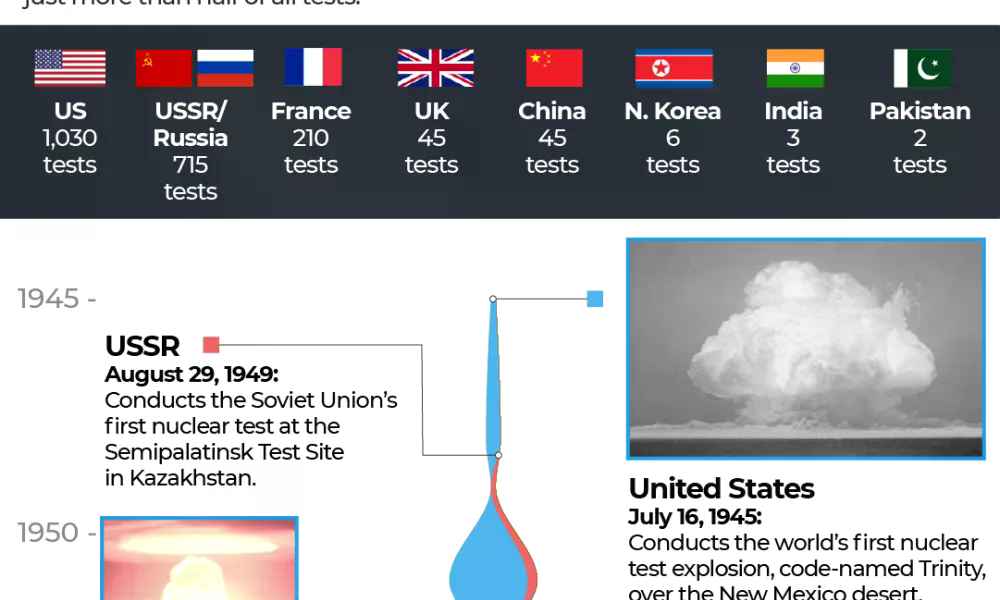
United States President Donald Trump announced on Thursday that he had directed the Department of War to “immediately” resume testing of U.S. nuclear weapons. This would mark the first time the United States has conducted such tests in over three decades.
Trump justified his decision by citing China’s rapid expansion of its nuclear stockpile, which he claimed posed a growing threat. His remarks came just before an anticipated summit with Chinese President Xi Jinping, during which a deal was reached on tariffs and rare earth metals. The announcement also followed his recent criticism of Russia for testing a new nuclear-powered missile known as the Burevestnik.
In a post on his Truth Social platform, Trump stated, “Because of other countries testing programs, I have instructed the Department of War to start testing our Nuclear Weapons on an equal basis.” He emphasized that while the U.S. possesses more nuclear weapons than any other country, China could surpass it within five years. Minutes later, Trump met with Xi Jinping in South Korea on the sidelines of the Asia-Pacific Economic Cooperation (APEC) summit.
The claim that China could match the U.S. nuclear arsenal in five years remains unverified. According to data from the Federation of American Scientists and the Stockholm International Peace Research Institute (SIPRI), China’s nuclear stockpile increased from 350 in 2022 to 410 in 2023. In comparison, the U.S. possessed 3,708 nuclear warheads in 2023, nearly nine times that number. Russia, however, presents a more complex picture.
On October 26, Russian President Vladimir Putin announced the successful test of the Burevestnik cruise missile, a nuclear-powered weapon. A day later, Trump criticized Putin for focusing on missile tests rather than addressing the conflict in Ukraine. Earlier this week, Putin also announced the successful test of the Poseidon underwater drone, a nuclear-capable unmanned vehicle. While the Poseidon is not currently armed with a nuclear warhead, its capabilities raise concerns about future developments.
Nuclear-powered platforms, such as aircraft carriers, missiles, or drones, derive their propulsion from nuclear fission, but they are not inherently nuclear weapons. A nuclear-capable weapon, like the Poseidon, can be equipped with a nuclear warhead, making it a potential nuclear weapon.
Most countries ceased nuclear testing after signing the Comprehensive Nuclear-Test-Ban Treaty (CTBT) in 1996. The treaty aims to prevent nuclear explosions for both military and civilian purposes. However, the U.S., which signed the CTBT in 1996, has never ratified it, meaning it is not legally bound by its provisions. Russia, which initially ratified the treaty in 2000, revoked its ratification in 2023, allowing it to conduct nuclear tests without legal consequences.
China, France, and the United Kingdom last tested nuclear weapons in 1996, while India and Pakistan conducted tests in 1998. North Korea has carried out five nuclear tests since 2006, and Israel maintains a policy of nuclear ambiguity, neither confirming nor denying its nuclear program.
Since the CTBT came into effect, only 10 nuclear tests have been conducted globally. These include India and Pakistan’s tests in 1998, as well as North Korea’s tests between 2006 and 2017. The treaty bans all nuclear explosions, but its enforcement relies on international cooperation and verification mechanisms.
The global nuclear landscape has seen shifts in recent years, with some states expanding their arsenals while others reduce them. A 2024 report by SIPRI warned that the world is approaching a new nuclear arms race, driven by the production of new warheads despite reductions in older ones. Weakened guardrails for controlling nuclear proliferation have further complicated the situation.
Iran has threatened to withdraw from the Nuclear Non-Proliferation Treaty (NPT), which entered into force in 1970. The NPT prohibits nuclear-weapon states from transferring nuclear technology to non-nuclear states and requires non-nuclear states to avoid acquiring nuclear weapons. India, Pakistan, and Israel have never signed the treaty, while North Korea withdrew in 2003.
Historically, nuclear arms control agreements have played a critical role in managing global tensions. During the Cold War, the U.S. and Soviet Union signed several treaties, including the Anti-Ballistic Missile (ABM) Treaty and the Intermediate-Range Nuclear Forces (INF) Treaty. However, many of these agreements have since collapsed, with the U.S. withdrawing from the INF Treaty in 2019 and the ABM Treaty in 2002.
As the geopolitical landscape continues to evolve, the resurgence of nuclear testing and the erosion of existing treaties pose significant challenges to global security and stability.


